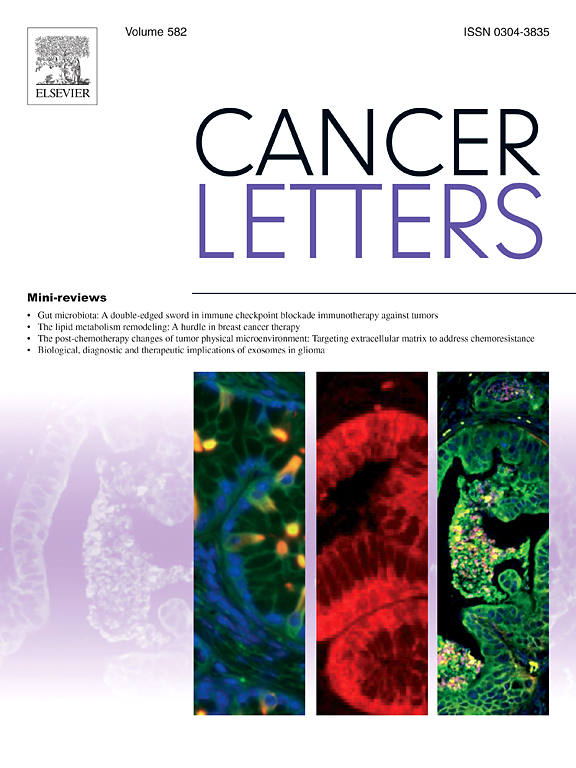侵袭性鼠伤寒沙门菌在胆囊中定植并通过激活宿主表观遗传调节剂KDM6B参与胆囊癌变。
IF 9.1
1区 医学
Q1 ONCOLOGY
引用次数: 0
摘要
胆囊结石本身并不能解释胆囊癌(GBC)风险的唯一病因。慢性微生物感染,特别是沙门氏菌,与GB致癌有关,但其致病作用和潜在机制在很大程度上是未知的。我们通过靶向宏基因组学研究了GBC的肠道和胆囊组织微生物组,以鉴定致病菌。采用全基因组测序、系统发育分析、突变谱分析和泛基因组分析等方法,对从GBC组织中分离到的鼠伤寒沙门菌进行毒力和致病性研究。在胆结石和慢性沙门氏菌感染小鼠模型、GBC (NOZ)细胞系细胞模型和异种移植肿瘤模型中进行了GBC致癌机制研究。我们发现GBC患者的肠道微生物群中沙门氏菌的丰度增加,而胆囊癌组织中可培养的鼠伤寒沙门氏菌则增加。从GBC组织中分离的鼠伤寒沙门氏菌的比较基因组学显示出较高的侵袭指数。鼠伤寒沙门氏菌分离物在其附属基因组中具有水平获得的毒力功能。慢性鼠伤寒沙门氏菌感染在小鼠模型和人GBC中通过激活表观遗传调节剂KDM6B,在胆囊结石小鼠模型中引起慢性炎症、恶性前改变和肿瘤促进机制。抑制KDM6B可减少SCID小鼠的移植物肿瘤大小。在人GBC组织中的差异调控基因中,ADAMTSL5、CX3CR1和SPSB4在感染沙门氏菌的NOZ细胞中也显著失调。慢性沙门氏菌感染通过涉及KDM6B的宿主表观遗传机制参与胆囊癌的发生。本文章由计算机程序翻译,如有差异,请以英文原文为准。
Invasive Salmonella Typhimurium colonizes gallbladder and contributes to gallbladder carcinogenesis through activation of host epigenetic modulator KDM6B
Gallbladder stones alone do not explain the risk of gallbladder cancer (GBC) as the sole etiological factor. Chronic microbial infection, particularly Salmonella, has been implicated in GB carcinogenesis, but its causative role and the underlying mechanisms are largely unknown. We studied gut and gallbladder tissue microbiome through targeted metagenomics to identify pathogenic bacteria in GBC. Virulence and pathogenicity of identified Salmonella Typhimurium from GBC tissue were studied after culture by whole genome sequencing, phylogenetic analysis, mutational profiling, and pangenome analysis. Mechanistic studies for GBC carcinogenesis were carried out in a mouse model of gallstones and chronic Salmonella infection, a cellular model using GBC (NOZ) cell lines, and a xenograft tumor model. We found an increased abundance of Salmonella in the gut microbiome of patients with GBC and culturable S. Typhimurium from the gallbladder cancer tissue. Comparative genomics of S. Typhimurium isolated from the GBC tissue showed a high invasive index. S. Typhimurium isolates harbored horizontally acquired virulence functions in their accessory genome. Chronic S. Typhimurium infection caused chronic inflammation, pre-malignant changes, and tumor-promoting mechanisms in the mouse model with gallbladder stones with activation of the epigenetic modulator KDM6B both in the mouse model and human GBC. Inhibition of KDM6B reduced engrafted tumor size in SCID mice. Of the differentially regulated genes in human GBC tissue, ADAMTSL5, CX3CR1, and SPSB4 were also significantly dysregulated in NOZ cells infected with Salmonella. Chronic Salmonella infection contributes to gallbladder carcinogenesis through a host epigenetic mechanism involving KDM6B.
求助全文
通过发布文献求助,成功后即可免费获取论文全文。
去求助
来源期刊

Cancer letters
医学-肿瘤学
CiteScore
17.70
自引率
2.10%
发文量
427
审稿时长
15 days
期刊介绍:
Cancer Letters is a reputable international journal that serves as a platform for significant and original contributions in cancer research. The journal welcomes both full-length articles and Mini Reviews in the wide-ranging field of basic and translational oncology. Furthermore, it frequently presents Special Issues that shed light on current and topical areas in cancer research.
Cancer Letters is highly interested in various fundamental aspects that can cater to a diverse readership. These areas include the molecular genetics and cell biology of cancer, radiation biology, molecular pathology, hormones and cancer, viral oncology, metastasis, and chemoprevention. The journal actively focuses on experimental therapeutics, particularly the advancement of targeted therapies for personalized cancer medicine, such as metronomic chemotherapy.
By publishing groundbreaking research and promoting advancements in cancer treatments, Cancer Letters aims to actively contribute to the fight against cancer and the improvement of patient outcomes.
 求助内容:
求助内容: 应助结果提醒方式:
应助结果提醒方式:


